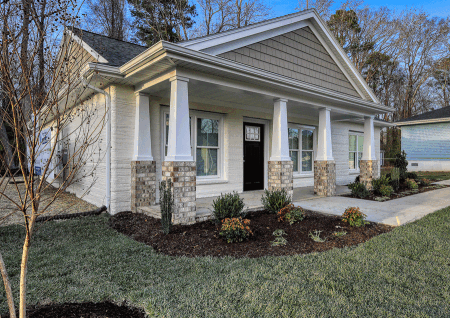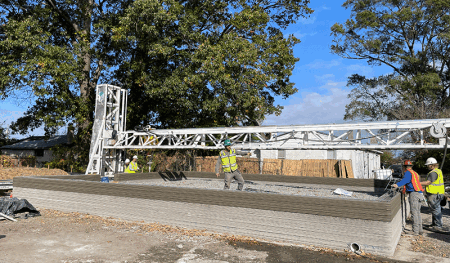At the beginning of 2023, a team of designers and architects reached a milestone in the nascent 3D-printing housing industry. Using technology that is relatively new to North America, the group began constructing a 4,000-square-foot (371 sq m), two-story home in a neighborhood of Houston using a massive 3D printer manufactured in Europe, marking the first time a multifloor home was built using a 3D printer, according to the team behind the project.
The concept of 3D-printing first burst onto the scene in the U.S. nearly 15 years ago, when the company MakerBot launched a desktop 3D printer company in Brooklyn. But 3D printing as a household name seemed to all but fade away as time went on until the last few years, when the concept of using 3D printers to create housing started to pick up steam. Now, the ongoing affordable housing crisis is forcing the country to look at innovative and creative solutions to get quality housing built at a lower cost, and it’s led to surging demand for 3D-printed houses.
The 3D-printed housing industry is so new, there is not much data to draw on to analyze how much it’s being adopted. And because many of the projects that have been done are scattered around the globe, it makes it hard to compare. However, based on anecdotal evidence from 3D printing companies, in certain settings, 3D-printed houses can be built faster than traditional construction and cost less. At a recent project in Williamsburg, Virginia, where 3D-printing technology was used to build a home for the non-profit Habitat for Humanity, the total cost to build was 15 percent less than traditional construction costs. The 3D printing company behind the project, Alquist 3D, took about 28 hours to print the exterior walls of the home.
Alquist was founded in 2020 and focuses its 3D-printing work on rural communities in the U.S. The company, in its previous iteration as Atlas Community Studios, worked on community development projects in more than 25 states. It’s what led founder and CEO Zachary Mannheimer to seek out solutions for the biggest problem he found in every place he worked: a lack of well-built, affordable housing.
After discovering 3D-printed structures in 2016 and becoming “obsessed” with the concept, he launched the company three years ago and has so far completed four homes in Virginia and has close to 250 in the pipeline. Demand is so strong, Mannheimer says he receives around 100 requests a day for 3D-printed homes from people around the world. “Finding work is not the issue,” Mannheimer says. “The issue is commercializing the industry and getting widespread acceptance.”
One myth he made a point to dispel is that it’s always cheaper to build using a 3D printer. In his experience, costs are often on par with traditional construction if just a single-family home is being built. However, the more buildings that are printed in a project, the more the costs will drop. That’s why the method could be particularly attractive to the multifamily industry, though Mannheimer admitted that it would probably be another year or two before the technology allows for it to be done at scale. There have only been a few multi-story projects aside from the home in Houston, most of which have been built overseas. But it is possible. And it’s something that, if done at scale, could help to create much-needed rental housing in areas around the country.
Philip Lund-Nielsen is the co-founder and head of Americas at COBOD, a Copenhagen-based company that manufactures 3D printers. His firm was one of the partners in the Houston project. Lund-Nielsen explained that COBOD’s printers are made up of modules that can be stacked like Legos to be able to print higher and wider as needed. While it sounds simple enough, there’s a bit of a learning curve for operating the machines. “3D printing is like learning how to ride a bike,” Lund-Nielsen says. “In the beginning you won’t be good, you’ll fall, but with time, you become better and better, and you’ll learn to ride without your hands.” So far, the tallest structure his firm’s technology has built was a three-story building in Germany with five apartments.
COBOD was founded in 2017 and has since sold 70 printers to clients around the world. The printers can come in different sizes, depending on project need, with costs starting at $600,000 for a full turnkey system. It has even partnered with General Electric, selling the corporation its largest printer to date for the company to construct 3D-printed pedestals for wind turbines. COBOD is seeing demand for its products continue to rise. Between 2019 and 2020, the company doubled its sales from the year before. From 2020 to 2021, sales tripled. Demand for the technology, especially from the U.S., is being driven by the skilled labor shortage in the construction industry, as well as the rising cost of materials and the increased focus on sustainability.
Lund-Nielsen believes that building even taller multi-floor multifamily housing is possible in the future, but that it will take more technological advancements first. He said his firm’s printers have the ability now to print up to 70 feet, which could mean a six-story building, but his firm is careful not to overestimate the capabilities of their 3D-printing technology. “We tend at COBOD to not set expectations too high because that will ruin the reputation of the industry itself,” he says. “We try to be realistic.”
Mannheimer says he frequently speaks to major home builders and industry trade groups about 3D-printed housing and is working on a couple initiatives to help startups get in the door, recruit and train a pipeline of talent to operate 3D printers, and create best practices for the industry. His firm is currently building a curriculum for a community college in Iowa that would train students how to operate 3D printers. Mannheimer and many others believe that 3D-printing is the future of construction and should be looked at as an advancement of the industry rather than a disruptor. “My prediction is by 2025, we’re going to see one of these on nearly every job site in America, complementing work that is happening,” he says.







